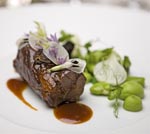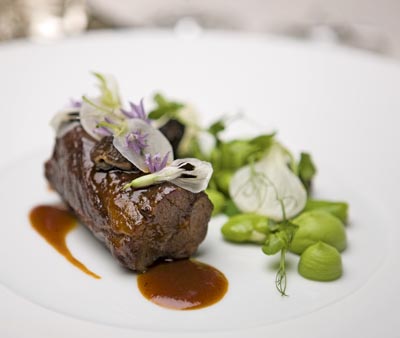Prince Charles shares his favourite recipe
Prince Charles has nominated mutton at The Ritz as his favourite recipe


You know that a foodstuff's star has waned when trolls turn up their noses at it. In The Hobbit, one of the menacing band that Bilbo Baggins encounters on the road to Rivendell is to be overheard complaining bitterly about his supper. ‘Mutton yesterday, mutton today, and blimey, if it don't look like mutton again tomorrer,' he grumbles.
The troll was very much a product of Tolkein's time. The Hobbit came out in 1937, when the tide of gastronomic taste was already beginning to turn against mutton-defined as meat from sheep that are more than two years old.
When the Second World War broke out, the drive to feed the populace as cheaply as possible meant that mutton, which by its very nature is a labour-intensive source of protein, was sidelined. Later, tasteless frozen imports that gave it a bad name swamped the market, and fine-grained, flavoursome cuts were done a terrible disservice by being boiled for hours on end.
By the 1960s, this former national treasure (Mrs Beeton doubted ‘whether any other joint is better liked') had a serious PR problem. The situation might never have changed had it not been for The Prince of Wales, whose Mutton Renaissance campaign (www.muttonrenaissance.org.uk) transformed the meat's fortunes-and those of British sheep farmers.
Today, mutton is proudly served in many of the smartest London hotels, including The Ritz. ‘This initiative would have gone nowhere without His Royal Highness,' emphasises its executive chef John Williams, who took over nine years ago after heading up the kitchens at Claridge's and The Berkeley. ‘It was his idea-he has a real passion for mutton, and it's frequently served at Highgrove. He contacted the Academy of Culinary Arts and said "I need your help-we've got to get it back on the menu".' A framed photograph of the pair at the campaign's 2004 launch, which took place at The Ritz, hangs proudly in Chef Williams's office.
The Prince of Wales, who had happy childhood memories of mutton dishes, felt it was ‘a tragedy that [the meat] had disappeared from the culinary experience of most people', and was determined to do everything he could to support sheep farmers that operated in a traditional way.
‘The idea behind it all,' Chef Williams explains, ‘was to make sure there was good husbandry in every aspect. This means selecting the right breed of sheep, finishing the animals on grass, making sure they're hung for long enough (two weeks mini-mum) and that they're raised on organic farms wherever possible.'
Exquisite houses, the beauty of Nature, and how to get the most from your life, straight to your inbox.
Like The Prince of Wales, Chef Williams is quick to sing mutton's praises. ‘I think it's magnificent. It has a very particular taste-"gamey lamb" is probably a good description, but that depends on how it's cooked. I'm a very Brit-ish type of chef, and for me, it's all about slow-cooking mutton, as in the recipe I've given here for braised navarin (neck).'
He continues: ‘Only once have I enjoyed it cooked as a fast dish, and that was when the great Indian chef Cyrus Todi-wala served a beautifully spiced dish of mutton that had been marinated in yoghurt and cooked on a griddle. It was superb, and he showed me you could do it.'
Almost a decade on from the launch of the Mutton Renais-sance, things are going from strength to strength. Producers such as Cumbria's Heritage Meats (www.heritagemeats.co.uk) and The Blackface Meat Company (www.blackface.co.uk) are widely celebrated for their mutton, and chefs including Hugh Fearnley-Whittingstall and Jamie Oliver have rallied round.
‘Consumption went up with immediate effect,' Chef Williams recalls. ‘So much so, in fact, that mutton is no longer a cheap meat. It's become almost as expensive as lamb!'
The Prince says: ‘It is so important that we eat mutton and that older sheep have a value, otherwise there's no market for them, and they just get dumped. I personally much prefer mutton to lamb-it's infinitely more tasty. Every time I have given mutton at dinners, the plates end up completely clean. Having mutton is also an excuse to have caper sauce, which I loved when I was a child.'
* Give Country Life for Christmas and save up to 40% on a subscription
Spring navarin of mutton
Serves 10 Ingredients
2kg mutton middle neck 60ml oil 60g butter 50g flour 700ml brown chicken stock 350ml tomato concasse (toma- toes that have been briefly plunged into boiling water, then iced water, before being skinned, deseeded and sliced) 350g mixed root vegetables (onions, leeks, celery, carrots and fennel) 80g tomato purée Seasoning
For the garnish
200g pea purée (made from 800g peas and 200g butter) 30 grellot onion 300g broad beans 30 morels 10 raw baby turnips 20 wild-garlic leaves Broad-bean flowers, pea shoots and wild-garlic flowers

Method
For the garnish, wash and peel all vegetables, then glaze in a mixture of water, butter, sugar and salt. They will be added to the stew at a later stage once tender.
Heat the oil and butter in a sauté pan and place the seasoned mutton pieces in the pan. Seal the meat briskly until it's very caramelised and season with salt, pepper and sugar.
The sugar settles on the bottom of the pan, where it turns to caramel. It's dissolved by moistening and ultimately will give the required colour and taste to the sauce.
Take the meat from the pan, then remove some of the fat. Add the root vegetables and sweat for a few minutes, then add the tomato purée. Add the flour and cook out briefly.
Add the stock a little at a time, mixing thoroughly to prevent lumps then add the tomato concasse. Bring to the boil and skim, then braise in the oven for approximately 2½ hours at 130˚C/ 250˚F/gas mark 1.
To make your pea purée, bring a pan of boiling salted water to the boil, add the peas and cook until soft. Remove from the water and add to a food processor, add butter and blitz until smooth.
Once the mutton is removed from the oven, decant the meat pieces and pass the braising liquor through a fine sieve onto them.
Finally, take the glazed vegetables and potatoes and add to the stew. Season to taste with chopped parsley and serve with pea purée.
Country Life is unlike any other magazine: the only glossy weekly on the newsstand and the only magazine that has been guest-edited by His Majesty The King not once, but twice. It is a celebration of modern rural life and all its diverse joys and pleasures — that was first published in Queen Victoria's Diamond Jubilee year. Our eclectic mixture of witty and informative content — from the most up-to-date property news and commentary and a coveted glimpse inside some of the UK's best houses and gardens, to gardening, the arts and interior design, written by experts in their field — still cannot be found in print or online, anywhere else.
